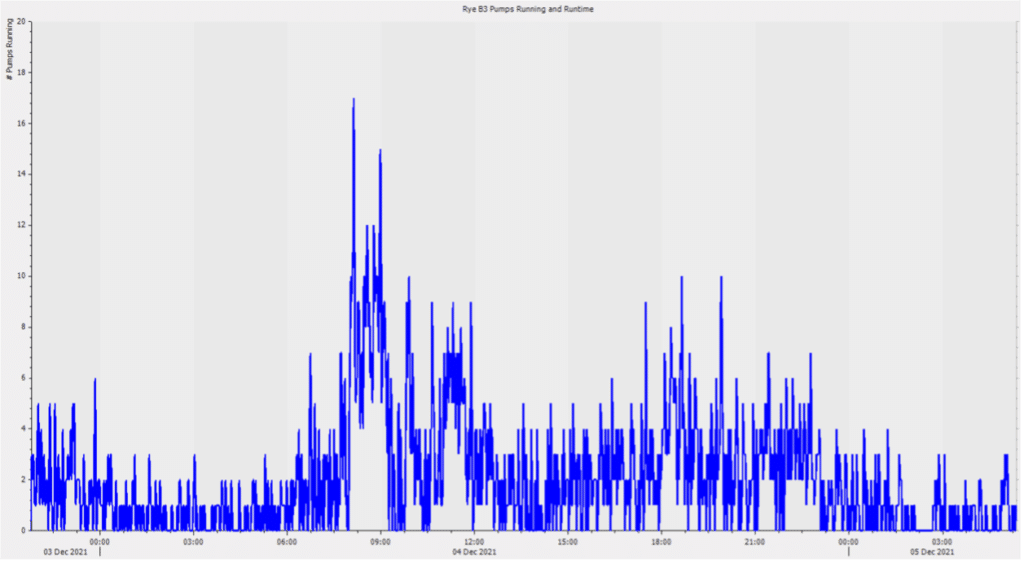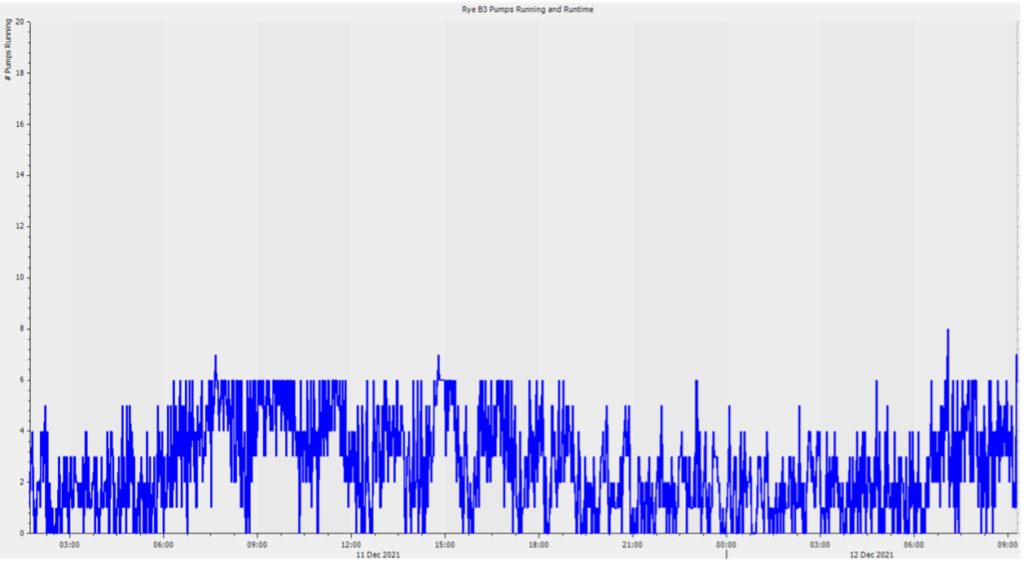Introduction
Iota’s unique OneBox® pressure sewer algorithm, proactively and centrally manages the entire network, to limit peak flows to a predetermined operator selected limit.
Targeting the control of concurrent pumping numbers within a catchment facilitates peak flow reduction to approximately 1.5 L/s times average flow, regardless of the scale of the catchment. OneBox® identifies infiltration after each rain event. To fully remove customer side infiltration from the network, the network operator can select the maximum desired flow threshold for a catchment, providing confidence of flow regardless of weather events.
Management of downstream asset constraints is critical for utilities. Significant capital savings can be realised via delayed or deferred downstream upgrades at treatment works, pump stations and networks. Conversely this flow control allows development to proceed ahead of planned infrastructure upgrades with confidence, thereby avoiding development delays.
Formal Field Trial Data
Field trials involved the application of the OneBox® Advanced Peak Shifting mode within the Rye B3 pressure sewer. This catchment consists of 500 residential connections located within South East Water’s Mornington Peninsula PenEco network. The scheme is based on a ClearSCADA controlled maximum threshold selection of 6 pumps pumping concurrently.
This catchment was selected on the basis it is infiltration free and of a reasonable scale, with a mix of holiday houses and principal residences, so daily flows are below expected residential flows. The trial compared the flow total (kL/d) and instantaneous peak flow (L/s), based on daily pump runtime in seconds and the concurrent pumping trend for Saturday 4th and Saturday 11th of December 2021. Advanced Peak Shifting mode was applied on the 8th of December and thereby active on the 11th of December.
December 4, 2021
Based on the OneBox® runtime data, 427 sites were active with a total daily runtime of 196,135 seconds and a total flow estimate of 107.87 kL/day (assumes pump rate 0.55 L/s). This equates to a relatively low flow of 252L per property per day. A reflection of the mix of residential and holiday homes within the catchment.
The peak flow (based on the concurrent pump trend below in figure 1 for the 4th of December) shows a short morning peak of 17 pumps at 8.30am. Equivalent to an instantaneous flow estimate of 9.35L/s (assumes pump rate 0.55 L/s).

December 11, 2021
Based on the OneBox® runtime data for 454 active residential connections, with total daily runtime of 225,276 secs, equating to a daily flow of 123.90 kL/day (based on pump rate 0.55 L/s). This equates to a relatively low flow of 273L per property per day.
The peak flow (based on the concurrent pump trend below in figure 2 for the 11th of December) shows a morning peak of 7 pumps at 8.00am, equivalent to instantaneous flow estimate of 3.85 L/s (assumes pump rate 0.55 L/s). Despite a slight increase in daily flow between the 4th and 11th, Iota achieved an estimated reduction in instantaneous flow from 9.35 L/s to 3.85 L/s.

Discussion
OneBox® Advanced Peak Shifting works by adjusting the cut in level throughout the day, to reduce likelihood of pumping at peak times, in conjunction with central control of the maximum number of concurrent pumps pumping within a catchment. The OneBox® requests permission to pump from the central server when cut in level is reached. For the trial, the instances where the concurrent pump number increased to 7 or 8 pumps (Fig 2) relates to automatic pumping without permission, in line with the Advanced Peak Shifting logic, to minimise risk of high-level float alarm trigger.
For residential development design purposes, Iota determines the average daily flow per property (based on recorded run time) then determines the optimal concurrent pump threshold setting (based on approx. 1.5 times average flow).
From observation of multiple residential networks, the following average figures are a reasonable starting point:
Sample catchment scale: 200 residential lots
Average residential daily flow: 400 L/day
Average pump rate: 0.55L/s
Total Daily Flow = 200 * 400 L/d = 80,000L/d
Average Flow = 80,000 / (24*60*60) L/s = 0.93 L/s
1.5 times Average Flow = 0.93 * 1.5 L/s = 1.39 L/s
Equivalent concurrent pumps = 1.39 / 0.55 = 2.52 (round up to 3 pumps pumping concurrently)
On this basis, for a 200 lot catchment, Iota would recommend setting the concurrent pump threshold to 3 pumps and therefore the peak flow expectation will be 1.65 L/s (3*0.55L/s) with potential short spikes to 4 or 5 pumps infrequently.
With the same design assumption as above, a 1,000 lot catchment will be set to a concurrent pump limit of 13 concurrent pumps, with associated peak flow of 7.15 L/s.
The demonstration catchment Rye B3 was slightly unusual as it is partly holiday house and partly full occupation, with lower daily flows and relatively high peak flows. This represents an ideal challenge to prove the Advanced Peak Shifting logic.
Application
Iota has determined that this centrally managed flow control significantly increases the capacity of downstream assets to accommodate development with benefit of either deferring expensive downstream asset upgrades or facilitating development pressure – freeing time for planning and development for future downstream asset upgrades.
The ability to identify and thereby remove infiltration in a monitored pressure sewer network, facilitates the opportunity to fully control the concurrent pumping limit in all weather conditions. Monitoring of the network via the OneBox® also facilities the interrogation of data, as lots are connected. Actual network inflows can be determined to optimise the system control ahead of full connections and associated peak flows.
Conclusion
The demonstration has successfully limited peak flow to the maximum set threshold of 6 concurrent pumps throughout the day, with the exception of a few isolated single pump events of 7 and 8 concurrent pumps. Since areas of Rye have marginal communications, it is anticipated that instances exceeding 6 relate to a comms delay between the site and ClearSCADA. Sites pump by default if no instruction received from ClearSCADA within the expected timeframes.
Iota therefore has successfully proven the ability to control the discharge from a OneBox® controlled pressure sewer network, within practical operator selected maximum threshold.



